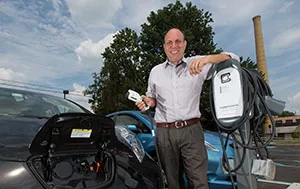Taking Charge

Erik Jensen '15, Ken McNeal of Facilities Services, and Tony Lee '15 stand before the solar panels the students installed along with an electric charging station for their senior engineering project.
Call it the senior gift that keeps on giving.
With graduation from Swarthmore fast approaching, engineering students Tony Lee ’15 and Erik Jensen ’15 wanted to leave something for the community. Something of lasting value that could spark conversations about sustainability on campus.
With a hand from the engineering faculty and Facilities Services staff, they made good on that, installing an electric charging station and solar panels on Field House Lane in May. It’s the first renewable energy source at the College, a symbol of progress and a call to action at once.
The technical aspects of their design and installation are complex. But the concept is simple, essentially: Users charge their car, and the sun foots the bill.
“We wanted to encourage people to adopt electric vehicles and offset the additional energy by putting roughly the same amount of solar energy back into the College grid,” says Lee, of Vancouver, British Columbia. “Although our project’s energy production is a drop in the bucket compared to what the College normally consumes, we hope the shared learning experience can help Swarthmore tackle bigger renewable energy projects in the future.”
The project traces back to a suggestion Ralph Thayer, director of maintenance, made to Carr Everbach, professor and chair of the Engineering Department, for students to design a solar array to charge the College’s eight electric maintenance vehicles.
“I just thought, ‘They make these. Why don’t we have one?’” says Thayer.

Richard Wicentowski, associate provost for educational programs and associate professor of computer science, charges his Nissan Leaf at the station.
Lee liked the concept and approached Jensen for help. They developed the plans for what would become their senior engineering project, with advice from Thayer and Tom Cochrane in Facilities Services; Everbach, with whom they met weekly; and the Sustainability Committee, from which they received a $10,000 grant from the Green Initiatives fund.
“I was just astounded with how many different parts of the Swarthmore community came together to help us with this project,” says Jensen, of Bethesda, Md.
The original idea was to build a solar carport that covered two parking spaces with a charging station below, but that proved financially and logistically impractical. They decided to connect it to the College grid, so that it could charge the grid in the daytime and pull energy from it at night.
The next question was where to put the array of solar panels, which came from nearby Open Sky Energy. Each of the sites Jensen and Lee considered had gas and electric lines below them, so they chose a self-ballasted ground mount system to place across the street from the Matchbox, in the line of sight of the charging station in the west lot of Field House Lane.
“Visibility was an important factor in choosing the project site," says Lee. "We wanted people to see the panels and think, 'Hey, that's neat. Maybe I'll do this at home.'”
Then, it was time to build. No small order, says Lee, “especially for two college students who hadn’t built anything this big before.”
The students collaborated closely with Facilities staff, in particular Bill Maguire and Ken McNeal, to get the project into the ground. (Think tunneling and cutting and pouring and wiring and … finally … flipping the switch.)
“We helped them in the trenches, so to speak,” says Thayer. “There were so many details to consider with the installation so that it would last, but the students were well versed.”
“Looking back on it, one of the things I cherished most was getting to work with the folks in Facilities and learning on the job,” says Lee.
The final product is aesthetically pleasing and technically proficient. It features two different levels of charges that can accommodate up to four vehicles at once, and its usage can be tracked by selecting Matchbox and then solar charging station electrical demand from the drop-down menu. The project's solar generation and resulting carbon impact can also be gauged in real time.
“It’s nice to have a project you can actually see is doing something,” says Thayer.
It’s also attracting users from the ranks of staff and faculty, the Board of Managers, and parents of students, who pop in to the station to get enough juice for the ride home or leave their car there for a few hours for a full charge.
“I see the project as aligning with the College’s larger aims on sustainability but also offering individuals an opportunity to make smarter energy choices,” says Rich Wicentowski, associate provost for educational programs and associate professor of computer science, who charges his Nissan Leaf at the station. “It’s providing a great incentive.”
Along with inspiration, the students hope.
“I’m really happy that we get to leave Swarthmore knowing we made a tangible, if small, impact,” says Jensen. “Hopefully this project is just the start for renewable energy projects on campus.”



